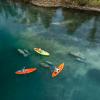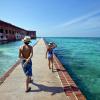By Nicki Collett
The scenic Chipola River flows nearly 100 miles through northwest Florida. Sixty-three freshwater springs nourish it, and no other river boasts so many springs in a state so dependent on its underground aquifer.
The Chipola River eventually joins the Apalachicola River after flowing through the Dead Lakes State Recreation Area. At one time the Apalach, as locals call it, blocked the Chipola with sand bars that flooded and killed thousands of trees, leaving graying skeletons over the sometimes flooded plain. There was no better name for the Dead Lakes area.
Aside from the ethereal look of Dead Lakes, the entire river is usually clear, beautiful and teeming with recreational boaters, paddlers, kayakers and tubers.
The springs along the Chipola River are breathtakingly clear. Blue Spring — every region has one — is among the largest and most popular springs. It contributes 122 million gallons of fresh water to the Chipola every day. From Look and Tremble Falls to Merritt’s Mill Pond, there is a sight to be seen in every nook and cranny. There are twists and turns, but the views and the wildlife make it worth the launch — barred owls, red-tailed hawks, kingfishers and alligators can be spotted. If you’re in the mood for exploring, stop in at The Ovens, a cave that can be easily explored with a headlamp or flashlight.
Although the exact origin of the name “Chipola” has been lost over time, some say it comes from the Choctaw language and means “sweet water.” And this isn’t a sweet spot just for water-enthusiasts — this region is the center for tupelo honey. Visitors travel from all over to sample and stock up on this sweet treat that had Van Morrison singing more than four decades ago. Tupelo trees only bloom for about five days in the spring, so beekeepers strip their hives and place them near tupelos and watch closely until the blooms fall away, signaling the end of the tupelo harvest along the swampy banks of the Chipola. It’s risky, hard work, but a bumper crop can reap $1 million shared among dozens of beekeepers in a good year.
Boat ramps can be found at Chipola Estates Landing and John Boy Landing in Calhoun County, Magnolia Landing in Jackson County, and 10 miles away at Yancey Bridge near Marianna. There’s a developed boat ramp and recreation area at Christoff Landing. And if you want to enjoy the Chipola at a slower pace, check out Chipola River Outfitters. Located a few miles west of Altha, the business will hook you up with kayaks, tubes, rafts, canoes or snorkels so you can explore one of Florida’s most beautiful and natural rivers with limestone shoals, sand beaches and rapids. Visit chipolariveroutfitters.com for more information.
Just north of Marianna is a state-designated canoe trail to Florida Caverns State Park — the only state park in Florida where the public can tour the dry caves and see spectacular limestone stalactite, stalagmite and soda-straw formations.
This spring-fed, cold-water river is home to the rare Coosa bass — and if you’re bream fishing, make sure to use your Beetle Spins, red worms and crickets. Just be cautious of shallow shoals during low water. Trim up your motor to avoid grounding.





















